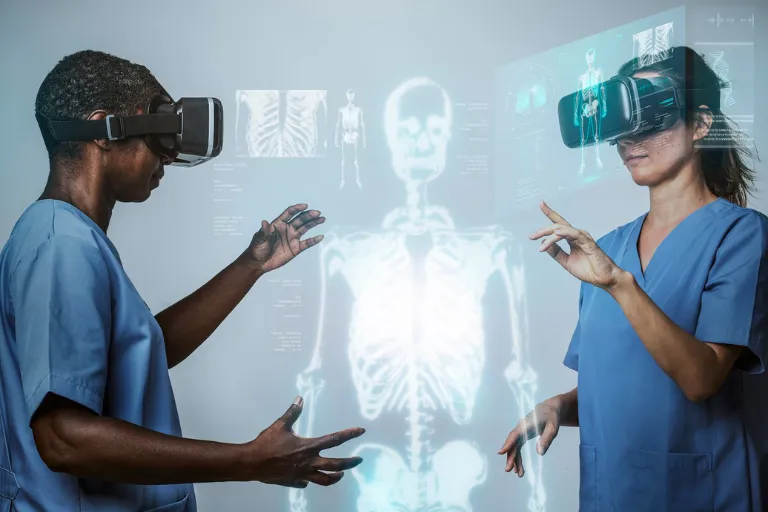Key Points:
- Artificial intelligence (AI) is transforming healthcare with advanced diagnostics, predictive analytics, and personalized therapies.
- AI demonstrates high accuracy in specialties like radiology and dermatology but faces challenges in real-world clinical settings.
- Ethical, professional, and human considerations make full replacement of health professionals unlikely.
- Experts see AI as a complement to, not a substitute for, the human side of medicine.
A New Era in Healthcare Innovation
Imagine walking into a hospital where the first diagnosis comes not from a human health professional but from an algorithm scanning your records, lab results, and potentially signals such as voice changes. What once sounded like science fiction is now quietly becoming reality. From cancer detection to predicting certain cardiovascular risks, AI has already entered labs, imaging departments, and is increasingly used in wearable devices – and it’s changing the way care is delivered.
But with rapid advances come difficult questions. If AI can outperform humans in certain diagnostic tasks, what does that mean for the role of health professionals? And beyond accuracy, can a machine truly replace the trust, empathy, and human judgment that users expect from healthcare? These questions are no longer theoretical – they’re shaping the future of medicine today.
Why the Rise of AI in Medicine Matters
Healthcare systems worldwide face mounting pressure from staff shortages, administrative overload, and rising costs. Users often wait weeks for appointments, while health professionals must balance limited time with growing demands. AI promises relief: faster diagnoses, streamlined paperwork, and therapies tailored to an individual’s unique biology.
Yet the paradox remains – greater reliance on algorithms sparks concerns about safety, equity, and the erosion of human touch in care. What’s at stake is not just efficiency but the very nature of the relationship between humans and the systems designed to protect their health.
Where AI Excels and Where It Still Falls Short
AI’s strengths lie in its ability to detect patterns at scale. Algorithms trained on millions of medical images can identify tumors or skin lesions with performance approaching those of human specialists – in specific tasks and controlled settings. Predictive models are also flagging users at risk of blood sugar regulation problems or heart problems earlier than conventional screening methods.
But AI struggles with the complexity of real-world settings. Algorithms are only as reliable as the data they learn from, and biases in training datasets can produce misdiagnoses. An AI trained primarily on European populations, for example, may underperform when analyzing diverse ethnic groups. Moreover, machines cannot yet replicate the human ability to sense when a user is too anxious or confused to follow instructions – an essential part of good care.
The Science Behind AI’s Healthcare Breakthroughs
At the core of AI’s success is machine learning, where algorithms “learn” from vast datasets. Radiology has become one of AI’s greatest success stories: deep learning systems now detect lung nodules or breast tissue abnormalities on scans with remarkable precision. In cardiology, AI can analyze electrocardiograms to spot rapid heartbeat or low resting heart rate patterns that even experienced health professionals may miss.
Another frontier is the development of a “digital twin” model – virtual replicas of a user’s body that simulate how different therapies might work. Natural language processing tools are also easing the burden of administrative work by summarizing records and assisting with documentation, saving valuable time for both users and health professionals.
Practical Applications: How AI Is Supporting Healthcare Today
AI is already shaping real-world healthcare, not by replacing health professionals but by extending their reach. Examples include:
- Accelerated diagnostics: Google’s DeepMind demonstrated AI models that recommended correct referral decisions for over 50 eye diseases with high accuracy – comparable to specialists, in a research setting.
- Tailored therapies: AI tools are helping design drug regimens personalized to genetic profiles.
- Reduced burnout: Automated charting and transcription tools are cutting hours of paperwork, freeing health professionals to focus on users.
- Wearable integration: Devices track vital signs and alert users to early warning signs of sleep problems, heart problems, or other concerns.
The greatest benefits arise when AI serves as a co-pilot – flagging issues for humans to confirm and contextualize.
Ethical and Professional Dilemmas of AI in Healthcare
With powerful tools come complex ethical questions. Who is accountable if an AI‐supported diagnosis is incorrect? How should health data be safeguarded when it powers these algorithms? Regulators such as the FDA are developing frameworks for approval, but policy often lags behind innovation.
Equally important is the question of trust. Users often value not just accuracy but also compassion and reassurance – qualities only humans provide. Health professionals can pick up on subtle cues such as anxious thoughts revealed through tone or hesitation – signals that algorithms are not equipped to interpret.
The Future of Medical Careers in an AI-Driven World
Rather than eliminating health professionals, AI is reshaping their roles. Data-heavy tasks may shift to algorithms, freeing humans to concentrate on user relationships, ethical oversight, and complex decision-making. Some predict new hybrid roles will emerge – health professionals with expertise in both medicine and data science.
Globally, AI could reduce disparities in low-resource regions by offering diagnostic support where trained health professionals are scarce. But access and affordability remain challenges, especially if cutting-edge systems remain confined to wealthier nations.
Next Steps: Embracing AI Without Losing Humanity
AI is not here to push humans out of healthcare – it’s here to help them work smarter. For users, the helpful next step is to ask your health professional how AI-driven solutions may complement your care. Understanding what technologies are available can empower you to make more informed decisions.
For health professionals, the challenge is learning to work with AI rather than against it. Those who adapt – by understanding how to interpret algorithmic recommendations, manage data responsibly, and preserve the human touch – will be better positioned to thrive in the future of medicine. Healthcare is strongest when human expertise and artificial intelligence combine, each amplifying the other’s strengths.
Conclusion: A Partnership, Not a Replacement
AI is already reshaping healthcare, but the evidence suggests it is not a replacement for the human touch. Instead, it should be viewed as a powerful partner – one that can relieve burdens, sharpen insights, and ultimately improve user outcomes. The stethoscope didn’t replace health professionals; it gave them a new way to listen. AI may serve the same role for the next generation of medicine.
This blog post aims to be informational and should not replace professional health advice. Always consult with a health professional for personalised advice.
Subscribe for Free for more insightful health articles tailored to your needs.
References
- Katsoulakis E, Wang Q, Wu H, Shahriyari L, Fletcher R, Liu J, et al. Digital twins for health: a scoping review. npj Digital Medicine. 2024 Mar 22;7(1):1–11.
- Liu X, Mitani A, Spitz T, Wu DJ, Ledsam JR. Google and DeepMind: Deep Learning Systems in Ophthalmology. Springer eBooks. 2021 Jan 1;161–76.
- Liu WT, Lin C, Lee CC, Chang CH, Fang WH, Tsai DJ, et al. Artificial Intelligence-Enabled ECGs for Atrial Fibrillation Identification and Enhanced Oral Anticoagulant Adoption: A Pragmatic Randomized Clinical Trial. Journal of the American Heart Association [Internet]. 2025 Autumn;14(14):e042106. Available from: https://pubmed.ncbi.nlm.nih.gov/40611485/




